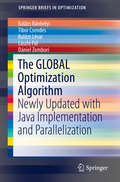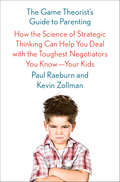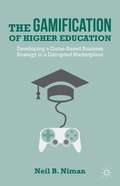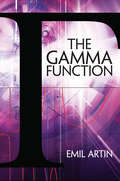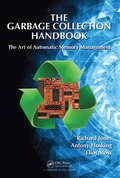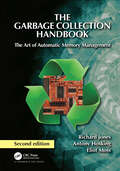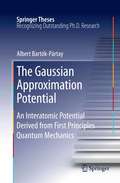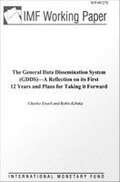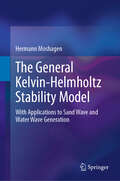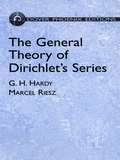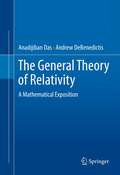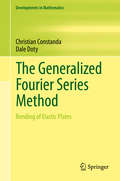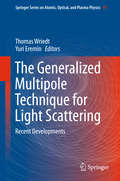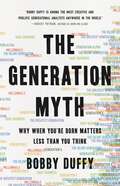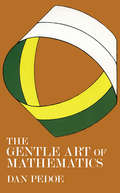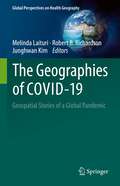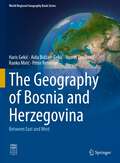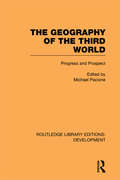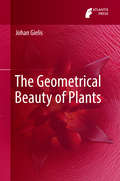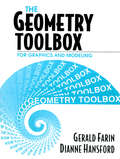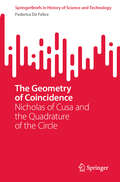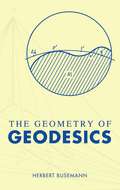- Table View
- List View
The GLOBAL Optimization Algorithm: Newly Updated With Java Implementation And Parallelization (SpringerBriefs in Optimization)
by Balázs Bánhelyi Tibor Csendes Balázs Lévai László Pál Dániel ZomboriThis book explores the updated version of the GLOBAL algorithm which contains improvements for a local search algorithm and new Java implementations. Efficiency comparisons to earlier versions and on the increased speed achieved by the parallelization, are detailed. Examples are provided for students as well as researchers and practitioners in optimization, operations research, and mathematics to compose their own scripts with ease. A GLOBAL manual is presented in the appendix to assist new users with modules and test functions. GLOBAL is a successful stochastic multistart global optimization algorithm that has passed several computational tests, and is efficient and reliable for small to medium dimensional global optimization problems. The algorithm uses clustering to ensure efficiency and is modular in regard to the two local search methods it starts with, but it can also easily apply other local techniques. The strength of this algorithm lies in its reliability and adaptive algorithm parameters. The GLOBAL algorithm is free to download also in the earlier Fortran, C, and MATLAB implementations.
The Game Theorist's Guide to Parenting: How the Science of Strategic Thinking Can Help You Deal with the Toughest Negotiators You Know—Your Kids
by Paul Raeburn Kevin Zollman“I absolutely loved this book, both as a parent and as a nerd.” —Jessica Lahey, author of The Gift of FailureDelightfully witty, refreshingly irreverent, and just a bit Machiavellian, The Game Theorist’s Guide to Parenting looks past the fads to offer advice you can put into action today. As every parent knows, kids are surprisingly clever negotiators. But how can we avoid those all-too-familiar wails of “That’s not fair!” and “You can’t make me!”? In The Game Theorist’s Guide to Parenting, the award-winning journalist and father of five Paul Raeburn and the game theorist Kevin Zollman pair up to highlight tactics from the worlds of economics and business that can help parents break the endless cycle of quarrels and ineffective solutions. Raeburn and Zollman show that some of the same strategies successfully applied to big business deals and politics—such as the Prisoner’s Dilemma and the Ultimatum Game—can be used to solve such titanic, age-old parenting problems as dividing up toys, keeping the peace on long car rides, and sticking to homework routines. Raeburn and Zollman open each chapter with a common parenting dilemma. Then they show how carefully concocted schemes involving bargains and fair incentives can save the day. Through smart case studies of game theory in action, Raeburn and Zollman reveal how parents and children devise strategies, where those strategies go wrong, and what we can do to help raise happy and savvy kids while keeping the rest of the family happy too.
The Gamification of Higher Education
by Neil B. NimanInstead of thinking about education as the mastery of a body of knowledge where the subject matter becomes the focus of our attention, The Gamification of Higher Education encourages us to think of it as a process that draws out the best in individuals and prepares them for happy, productive, and successful lives.
The Gamma Function (Dover Books on Mathematics)
by Emil Artin Michael ButlerThis brief monograph on the gamma function was designed by the author to fill what he perceived as a gap in the literature of mathematics, which often treated the gamma function in a manner he described as both sketchy and overly complicated. Author Emil Artin, one of the twentieth century's leading mathematicians, wrote in his Preface to this book, "I feel that this monograph will help to show that the gamma function can be thought of as one of the elementary functions, and that all of its basic properties can be established using elementary methods of the calculus." Generations of teachers and students have benefitted from Artin's masterly arguments and precise results. Suitable for advanced undergraduates and graduate students of mathematics, his treatment examines functions, the Euler integrals and the Gauss formula, large values of x and the multiplication formula, the connection with sin x, applications to definite integrals, and other subjects.
The Garbage Collection Handbook: The Art of Automatic Memory Management (Chapman & Hall/CRC Applied Algorithms and Data Structures series)
by Richard Jones Antony Hosking Eliot MossPublished in 1996, Richard Jones’s Garbage Collection was a milestone in the area of automatic memory management. The field has grown considerably since then, sparking a need for an updated look at the latest state-of-the-art developments. The Garbage Collection Handbook: The Art of Automatic Memory Management brings together a wealth of knowledge gathered by automatic memory management researchers and developers over the past fifty years. The authors compare the most important approaches and state-of-the-art techniques in a single, accessible framework. The book addresses new challenges to garbage collection made by recent advances in hardware and software. It explores the consequences of these changes for designers and implementers of high performance garbage collectors. Along with simple and traditional algorithms, the book covers parallel, incremental, concurrent, and real-time garbage collection. Algorithms and concepts are often described with pseudocode and illustrations. The nearly universal adoption of garbage collection by modern programming languages makes a thorough understanding of this topic essential for any programmer. This authoritative handbook gives expert insight on how different collectors work as well as the various issues currently facing garbage collectors. Armed with this knowledge, programmers can confidently select and configure the many choices of garbage collectors. Web ResourceThe book’s online bibliographic database at www.gchandbook.org includes over 2,500 garbage collection-related publications. Continually updated, it contains abstracts for some entries and URLs or DOIs for most of the electronically available ones. The database can be searched online or downloaded as BibTeX, PostScript, or PDF. E-bookThis edition enhances the print version with copious clickable links to algorithms, figures, original papers and definitions of technical terms. In addition, each index entry links back to where it was mentioned in the text, and each entry in the bibliography includes links back to where it was cited.
The Garbage Collection Handbook: The Art of Automatic Memory Management (International Perspectives On Science, Culture And Society Ser.)
by Richard Jones Antony Hosking Eliot MossPublished in 1996, Richard Jones's Garbage Collection was a milestone in the area of automatic memory management. Its widely acclaimed successor, The Garbage Collection Handbook: The Art of Automatic Memory Management, captured the state of the field in 2012. Modern technology developments have made memory management more challenging, interesting and important than ever. This second edition updates the handbook, bringing together a wealth of knowledge gathered by automatic memory management researchers and developers over the past sixty years. The authors compare the most important approaches and state-of-the-art techniques in a single, accessible framework. The book addresses new challenges to garbage collection made by recent advances in hardware and software. It explores the consequences of these changes for designers and implementers of high performance garbage collectors. Along with simple and traditional algorithms, the book covers state-of-the-art parallel, incremental, concurrent and real-time garbage collection. Algorithms and concepts are often described with pseudocode and illustrations. Features of this edition Provides a complete, up-to-date, and authoritative sequel to the 1996 and 2012 books Offers thorough coverage of parallel, concurrent, and real-time garbage collection algorithms Discusses in detail modern, high-performance commercial collectors Explains some of the trickier aspects of garbage collection, including the interface to the run-time system Over 90 more pages including new chapters on persistence and energy-aware garbage collection Backed by a comprehensive online database of over 3,400 garbage collection-related publications The adoption of garbage collection by almost all modern programming languages makes a thorough understanding of this topic essential for any programmer. This authoritative handbook gives expert insight on how different collectors work as well as the various issues currently facing garbage collectors. Armed with this knowledge, programmers can confidently select and configure the many choices of garbage collectors.
The Gaussian Approximation Potential
by Albert Bartók-PártaySimulation of materials at the atomistic level is an important tool in studying microscopic structures and processes. The atomic interactions necessary for the simulations are correctly described by Quantum Mechanics, but the size of systems and the length of processes that can be modelled are still limited. The framework of Gaussian Approximation Potentials that is developed in this thesis allows us to generate interatomic potentials automatically, based on quantum mechanical data. The resulting potentials offer several orders of magnitude faster computations, while maintaining quantum mechanical accuracy. The method has already been successfully applied for semiconductors and metals.
The Gen Y Handbook
by Diane E. SpiegelWith four generations simultaneously co-habitating today's workplace, miscommunication and dissatisfaction are prevalent. Generation Y is the newest generation to enter our workforce and they pose a whole new set of particularly thorny issues, especially when it is their elders who must manage them. So how can you, as a leader, help them reach their full potential? In The Gen Y Handbook: Applying Relationship Leadership to Engage Millennials Diane Spiegel takes a close look into the workings of the Gen Y mind-how they operate, their strengths, their weaknesses, and how to effectively engage the wide range of abilities at their disposal. The Gen Y Handbook was written to help managers and business leaders avoid the pitfalls that multigenerational workforces can cause, while aiding in the implementation of the best techniques and most efficient ways of utilizing Millennial talent. Spiegel explains the particularities of Generation Y, why they are the way they are, and how to understand these differences without negative judgment.
The General Data Dissemination System (GDDS)--A Reflection on its First 12 Years and Plans for Taking it Forward
by Charles Enoch Robin KibukaA report from the International Monetary Fund.
The General Kelvin-Helmholtz Stability Model: With Applications to Sand Wave and Water Wave Generation
by Hermann MoshagenThis book presents a generalized version of the classical Kelvin-Helmholtz instability, a useful tool which allows for new approaches when studying stability problems in fluid mechanics, as well as its important applications. It begins by providing an introduction to hydrodynamic stability and the Kelvin-Helmholtz (KH) instability. The author then develops the general KH stability model for a multi-layer flow system, which includes the conventional KH instability as a special case. This book also includes the detailed discussion of two important applications of this model: the generation of sand waves in alluvial channels and the generation of wind waves on water. Additionally, the effects of nonlinearities and the use of computational methods to study KH instability are included. This book serves as a concise and modern treatment of the KH stability model with specific attention paid to hydrodynamic stability analysis. It is ideal for graduate students interested in fluid dynamics as well as scientists and engineers in the fields of oceanography, geophysics, offshore engineering, and more.
The General Theory of Dirichlet's Series (Dover Books on Mathematics)
by G. H. Hardy Marcel RieszThis classic work explains the theory and formulas behind Dirichlet's series and offers the first systematic account of Riesz's theory of the summation of series by typical means. Its authors rank among the most distinguished mathematicians of the twentieth century: G. H. Hardy is famous for his achievements in number theory and mathematical analysis, and Marcel Riesz's interests ranged from functional analysis to partial differential equations, mathematical physics, number theory, and algebra.Following an introduction, the authors proceed to a discussion of the elementary theory of the convergence of Dirichlet's series, followed by a look at the formula for the sum of the coefficients of a Dirichlet's series in terms of the order of the function represented by the series. They continue with an examination of the summation of series by typical means and of general arithmetic theorems concerning typical means. After a survey of Abelian and Tauberian theorems and of further developments of the theory of functions represented by Dirichlet's series, the text concludes with an exploration of the multiplication of Dirichlet's series.
The General Theory of Relativity
by Andrew Debenedictis Anadijiban DasThe General Theory of Relativity: A Mathematical Exposition will serve readers as a modern mathematical introduction to the general theory of relativity. Throughout the book, examples, worked-out problems, and exercises (with hints and solutions) are furnished. Topics in this book include, but are not limited to: tensor analysis the special theory of relativity the general theory of relativity and Einstein's field equations spherically symmetric solutions and experimental confirmations static and stationary space-time domains black holes cosmological models algebraic classifications and the Newman-Penrose equations the coupled Einstein-Maxwell-Klein-Gordon equations appendices covering mathematical supplements and special topics Mathematical rigor, yet very clear presentation of the topics make this book a unique text for both university students and research scholars. Anadijiban Das has taught courses on Relativity Theory at The University College of Dublin, Ireland, Jadavpur University, India, Carnegie-Mellon University, USA, and Simon Fraser University, Canada. His major areas of research include, among diverse topics, the mathematical aspects of general relativity theory. Andrew DeBenedictis has taught courses in Theoretical Physics at Simon Fraser University, Canada, and is also a member of The Pacific Institute for the Mathematical Sciences. His research interests include quantum gravity, classical gravity, and semi-classical gravity.
The Generalized Fourier Series Method: Bending of Elastic Plates (Developments in Mathematics #65)
by Christian Constanda Dale DotyThis book explains in detail the generalized Fourier series technique for the approximate solution of a mathematical model governed by a linear elliptic partial differential equation or system with constant coefficients. The power, sophistication, and adaptability of the method are illustrated in application to the theory of plates with transverse shear deformation, chosen because of its complexity and special features. In a clear and accessible style, the authors show how the building blocks of the method are developed, and comment on the advantages of this procedure over other numerical approaches. An extensive discussion of the computational algorithms is presented, which encompasses their structure, operation, and accuracy in relation to several appropriately selected examples of classical boundary value problems in both finite and infinite domains. The systematic description of the technique, complemented by explanations of the use of the underlying software, will help the readers create their own codes to find approximate solutions to other similar models. The work is aimed at a diverse readership, including advanced undergraduates, graduate students, general scientific researchers, and engineers.The book strikes a good balance between the theoretical results and the use of appropriate numerical applications. The first chapter gives a detailed presentation of the differential equations of the mathematical model, and of the associated boundary value problems with Dirichlet, Neumann, and Robin conditions. The second chapter presents the fundamentals of generalized Fourier series, and some appropriate techniques for orthonormalizing a complete set of functions in a Hilbert space. Each of the remaining six chapters deals with one of the combinations of domain-type (interior or exterior) and nature of the prescribed conditions on the boundary. The appendices are designed to give insight into some of the computational issues that arise from the use of the numerical methods described in the book.Readers may also want to reference the authors’ other books Mathematical Methods for Elastic Plates, ISBN: 978-1-4471-6433-3 and Boundary Integral Equation Methods and Numerical Solutions: Thin Plates on an Elastic Foundation, ISBN: 978-3-319-26307-6.
The Generalized Multipole Technique for Light Scattering: Recent Developments (Springer Series on Atomic, Optical, and Plasma Physics #99)
by Thomas Wriedt Yuri EreminThis book presents the Generalized Multipole Technique as a fast and powerful theoretical and computation tool to simulate light scattering by nonspherical particles. It also demonstrates the considerable potential of the method. In recent years, the concept has been applied in new fields, such as simulation of electron energy loss spectroscopy and has been used to extend other methods, like the null-field method, making it more widely applicable. The authors discuss particular implementations of the GMT methods, such as the Discrete Sources Method (DSM), Multiple Multipole Program (MMP), the Method of Auxiliary Sources (MAS), the Filamentary Current Method (FCM), the Method of Fictitious Sources (MFS) and the Null-Field Method with Discrete Sources (NFM-DS). The Generalized Multipole Technique is a surface-based method to find the solution of a boundary-value problem for a given differential equation by expanding the fields in terms of fundamental or other singular solutions of this equation. The amplitudes of these fundamental solutions are determined from the boundary condition at the particle surface. Electromagnetic and light scattering by particles or systems of particles has been the subject of intense research in various scientific and engineering fields, including astronomy, optics, meteorology, remote sensing, optical particle sizing and electromagnetics, which has led to the development of a large number of modelling methods based on the Generalized Multipole Technique for quantitative evaluation of electromagnetic scattering by particles of various shapes and compositions. The book describes these methods in detail.
The Generation Myth: Why When You're Born Matters Less Than You Think
by Bobby DuffyMillennials, Baby Boomers, Gen Z—we like to define people by when they were born, but an acclaimed social researcher explains why we shouldn't.Boomers are narcissists. Millennials are spoiled. Gen Zers are lazy. We assume people born around the same time have basically the same values. It makes for good headlines, but is it true?Bobby Duffy has spent years studying generational distinctions. In The Generation Myth, he argues that our generational identities are not fixed but fluid, reforming throughout our lives. Based on an analysis of what over three million people really think about homeownership, sex, well-being, and more, Duffy offers a new model for understanding how generations form, how they shape societies, and why generational differences aren&’t as sharp as we think.The Generation Myth is a vital rejoinder to alarmist worries about generational warfare and social decline. The kids are all right, it turns out. Their parents are too.
The Gentle Art of Mathematics
by Dan PedoeMathematical games, probability, the question of infinity, topology, how the laws of algebra work, problems of irrational numbers, and more. 42 figures.
The Geographies of COVID-19: Geospatial Stories of a Global Pandemic (Global Perspectives on Health Geography)
by Melinda Laituri Robert B. Richardson Junghwan KimThis volume of case studies focuses on the geographies of COVID-19 around the world. These geographies are located in both time and space concentrating on both first- and second-order impacts of the COVID-19 pandemic. First-order impacts are those associated with the immediate response to the pandemic that include tracking number of deaths and cases, testing, access to hospitals, impacts on essential workers, searching for the origins of the virus and preventive treatments such as vaccines and contact tracing. Second-order impacts are the result of actions, practices, and policies in response to the spread of the virus, with longer-term effects on food security, access to health services, loss of livelihoods, evictions, and migration. Further, the COVID-19 pandemic will be prolonged due to the onset of variants as well as setting the stage for similar future events. This volume provides a synopsis of how geography and geospatial approaches are used to understand this event and the emerging “new normal.” The volume's approach is necessarily selective due to the global reach of the pandemic and the broad sweep of second-order impacts where important issues may be left out. However, the book is envisioned as the prelude to an extended conversation about adaptation to complex circumstances using geospatial tools.Using case studies and examples of geospatial analyses, this volume adopts a geographic lens to highlight the differences and commonalities across space and time where fundamental inequities are exposed, the governmental response is varied, and outcomes remain uncertain. This moment of global collective experience starkly reveals how inequality is ubiquitous and vulnerable populations – those unable to access basic needs – are increasing. This place-based approach identifies how geospatial analyses and resulting maps depict the pandemic as it ebbs and flows across the globe. Data-driven decision making is needed as we navigate the pandemic and determine ways to address future such events to enable local and regional governments in prioritizing limited resources to mitigate the long-term consequences of COVID-19.
The Geography of Bosnia and Herzegovina: Between East and West (World Regional Geography Book Series)
by Haris Gekić Aida Bidžan-Gekić Nusret Drešković Ranko Mirić Péter ReményiThis monograph provides a comprehensive overview of fundamental scientific insights into the geographical features of a country which was and still is in the centre of the geopolitical battle of the large world powers and especially neighboring countries. The book presents the scientifically proven reserves of individual resources such as: mineral riches, land, forests, flora and fauna, water and climate features, to the extent needed, through statistical indicators and geographic maps. The authors point to features and specifics of the existing interdependence of economic and political development and impact of natural resources on spatial development which can be useful for potential investors, spatial planers, decision makers, politicians, geographers, students, large Bosnian diaspora and anyone interested in area of Bosnia and Herzegovina. This book fills the gap in geographical literature on Bosnia and Herzegovina in the English language. The monograph appeals to researchers and scholars of all levels in the fields of geography, geopolitics, history and related fields and everyone interested in this country between East and West.
The Geography of the Third World: Progress and Prospect (Routledge Library Editions: Development)
by Michael PacioneFirst published in 1988, this reissue presents a comprehensive overview of contemporary developments and research into the geography of the Third World, at a time when economies and societies there were changing at a much more rapid rate than their counterparts in the developing world. It covers the topic both systematically and by region, showing how the unique background of each region affects developments there.
The Geometric Theory of Complex Variables
by Steven G. Krantz Peter V. DovbushThis book provides the reader with a broad introduction to the geometric methodology in complex analysis. It covers both single and several complex variables, creating a dialogue between the two viewpoints. Regarded as one of the 'grand old ladies' of modern mathematics, complex analysis traces its roots back 500 years. The subject began to flourish with Carl Friedrich Gauss's thesis around 1800. The geometric aspects of the theory can be traced back to the Riemann mapping theorem around 1850, with a significant milestone achieved in 1938 with Lars Ahlfors's geometrization of complex analysis. These ideas inspired many other mathematicians to adopt this perspective, leading to the proliferation of geometric theory of complex variables in various directions, including Riemann surfaces, Teichmüller theory, complex manifolds, extremal problems, and many others. This book explores all these areas, with classical geometric function theory as its main focus. Its accessible and gentle approach makes it suitable for advanced undergraduate and graduate students seeking to understand the connections among topics usually scattered across numerous textbooks, as well as experienced mathematicians with an interest in this rich field.
The Geometrical Beauty of Plants
by Johan GielisThis book focuses on the origin of the Gielis curves, surfaces and transformations in the plant sciences. It is shown how these transformations, as a generalization of the Pythagorean Theorem, play an essential role in plant morphology and development. New insights show how plants can be understood as developing mathematical equations, which opens the possibility of directly solving analytically any boundary value problems (stress, diffusion, vibration. . . ) . The book illustrates how form, development and evolution of plants unveil as a musical symphony. The reader will gain insight in how the methods are applicable in many divers scientific and technological fields.
The Geometry Toolbox for Graphics and Modeling
by Gerald Farin Dianne HansfordThe Geometry Toolbox takes a novel and particularly visual approach to teaching the basic concepts of two- and three-dimensional geometry. It explains the geometry essential for today's computer modeling, computer graphics, and animation systems. While the basic theory is completely covered, the emphasis of the book is not on abstract proofs but rather on examples and algorithms. The Geometry Toolbox is the ideal text for professionals who want to get acquainted with the latest geometric tools. The chapters on basic curves and surfaces form an ideal stepping stone into the world of graphics and modeling. It is also a unique textbook for a modern introduction to linear algebra and matrix theory.
The Geometry of Accounting: From Debits and Credits to Cartesian Coordinates (Springer Texts in Business and Economics)
by Byung T. RoThis book demonstrates how geometry along with linear algebra can be used to learn and study accounting. It explains how to present (record) economic transactions (accounting transactions or events) and explores the features and principles of double entry accounting based on geometric concepts and theories in multidimensional Cartesian geometric and vector spaces. The geometric approach in this book is concerned with the production of accounting numbers and the entry rather than exit side of accounting. It is markedly different from the traditional approach to learning, studying, and teaching accounting. This book is intended for graduate accounting students, accounting educators, and accounting scholars alike, who are interested in accounting beyond the basics and have some knowledge of geometry and linear algebra.
The Geometry of Coincidence: Nicholas of Cusa and the Quadrature of the Circle (SpringerBriefs in History of Science and Technology)
by Federica De FeliceThis book offers a contribution to our understanding of Nicholas of Cusa&’s theory of geometry. It is based not only on his—generally more famous—philosophical texts (e.g., De docta ignorantia, Idiota, etc.), but also, and more significantly, on the strictly speaking mathematical texts drafted between 1445 and 1459, where Cusanus attempts to provide a solution to the vexata quaestio of the squaring of the circle. First critically edited in 2010—and translated into Italian by the author in 2020—Cusanus&’ Scripta mathematica are here scrutinized as to their context, genesis, and content, in order to shed light, on the one hand, on the philosophical and theological motives behind Cusanus&’ mathematical endeavours; and, on the other hand, on the scope and limits of Cusanus&’ geometrical constructive attempts to reach &“mathematical perfection&”. In addition to providing a scrupulous survey of Cusanus&’ sources on mathematics, this book focuses on a little explored aspect in Cusanus&’ work, namely his original theory of geometrical space as men&’s space, where the activity of mensurare takes place, establishing relations of continuous proportionality to the original unity. In conclusion, the author provides an extensive account on the reception of Cusanus&’ mathematical texts, from their early dissemination to the reactions of several thinkers throughout history, ensuring a full and rounded overview of Cusanus&’ work in geometry, mathematics, and philosophy.
The Geometry of Geodesics
by Herbert BusemannA comprehensive approach to qualitative problems in intrinsic differential geometry, this text for upper-level undergraduates and graduate students emphasizes cases in which geodesics possess only local uniqueness properties--and consequently, the relations to the foundations of geometry are decidedly less relevant, and Finsler spaces become the principal subject.This direct approach has produced many new results and has materially generalized many known phenomena. Author Herbert Busemann begins with an explanation of the basic concepts, including compact metric spaces, convergence of point sets, motion and isometry, segments, and geodesics. Subsequent topics include Desarguesian spaces, with discussions of Riemann and Finsler spaces and Beltrami's theorem; perpendiculars and parallels, with examinations of higher-dimensional Minkowskian geometry and the Minkowski plane; and covering spaces, including locally isometric space, the universal covering space, fundamental sets, free homotopy and closed geodesics, and transitive geodesics on surfaces of higher genus. Concluding chapters explore the influence of the sign of the curvature on the geodesics, and homogenous spaces, including those with flat bisectors.
